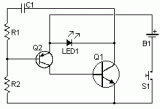Infrared schematics
 A very simple device allowing a quick check of common Infra-red Remote-Controls can be useful to the electronics amateur, frequently asked to repair or test these ubiquitous devices. A reliable circuit was designed with a handful of components: the LED will flash when any of the Remote-Control push buttons will be pressed. The side of the Remote-Control bearing the IR emitting diode(s) must be directed towards the Photo Transistor (Q1) of the checker circuit: maximum distance should not exceed about 20 - 25cm....
[read more]
A very simple device allowing a quick check of common Infra-red Remote-Controls can be useful to the electronics amateur, frequently asked to repair or test these ubiquitous devices. A reliable circuit was designed with a handful of components: the LED will flash when any of the Remote-Control push buttons will be pressed. The side of the Remote-Control bearing the IR emitting diode(s) must be directed towards the Photo Transistor (Q1) of the checker circuit: maximum distance should not exceed about 20 - 25cm....
[read more]
 This small circuit is ideal for checking the basic operation of an infrared remote control unit. The circuit is based on the brilliantly simple idea of connecting a piezo buzzer directly to an IR receiver IC. This method is almost as simple as connecting a photodiode directly to the input of an oscilloscope, but has the advantage that no oscilloscope is needed: the compact unit is always ready to use and much easier to carry around than bulky test equipment....
[read more]
This small circuit is ideal for checking the basic operation of an infrared remote control unit. The circuit is based on the brilliantly simple idea of connecting a piezo buzzer directly to an IR receiver IC. This method is almost as simple as connecting a photodiode directly to the input of an oscilloscope, but has the advantage that no oscilloscope is needed: the compact unit is always ready to use and much easier to carry around than bulky test equipment....
[read more]
 Men in particular enjoy the convenience of television remote controls – often to the annoyance of their female partners. Men apparently want to know what they’re missing when the TV is tuned to a particular program, so they like to keep zapping to other channels. With the remote control in their hands, they feel like they are the lord and master of the TV set. They are thus completely at a loss if the remote control doesn’t work properly. There are many reasons why a remote control unit can malfunction, such as defective IR receiver in the TV set, a defect in the remote control, or empty batteries. Here a tester that can determine whether the remote control unit still emits an IR signal can come in handy. If you want to keep the IR reins firmly in hand, you can build your own IR detector....
[read more]
Men in particular enjoy the convenience of television remote controls – often to the annoyance of their female partners. Men apparently want to know what they’re missing when the TV is tuned to a particular program, so they like to keep zapping to other channels. With the remote control in their hands, they feel like they are the lord and master of the TV set. They are thus completely at a loss if the remote control doesn’t work properly. There are many reasons why a remote control unit can malfunction, such as defective IR receiver in the TV set, a defect in the remote control, or empty batteries. Here a tester that can determine whether the remote control unit still emits an IR signal can come in handy. If you want to keep the IR reins firmly in hand, you can build your own IR detector....
[read more]
 The IR detector (IC3) controls an LM 7555 CMOS timer (IC2) which operates in mono stable mode. When the beam is broken, IC2 is triggered and its pin 3 output goes high for about half a second. This extinguishes LED1 and turns on transistor Q1 to drive a 5V low-power relay....
[read more]
The IR detector (IC3) controls an LM 7555 CMOS timer (IC2) which operates in mono stable mode. When the beam is broken, IC2 is triggered and its pin 3 output goes high for about half a second. This extinguishes LED1 and turns on transistor Q1 to drive a 5V low-power relay....
[read more]
 Using this circuit, audio musical notes can be generated and heard up to a distance of 10 metres. The circuit can be divided into two parts: IR music transmitter and receiver. The IR music transmitter works off a 9V battery, while the IR music receiver works off regulated 9V to 12V. First diagram shows the circuit of the IR music transmitter. It uses popular melody generator IC UM66 (IC1) that can continuously generate musical tones....
[read more]
Using this circuit, audio musical notes can be generated and heard up to a distance of 10 metres. The circuit can be divided into two parts: IR music transmitter and receiver. The IR music transmitter works off a 9V battery, while the IR music receiver works off regulated 9V to 12V. First diagram shows the circuit of the IR music transmitter. It uses popular melody generator IC UM66 (IC1) that can continuously generate musical tones....
[read more]
 Most of the IR remotes work reliably within a range of 5 metres. The circuit complexity increases if you design the IR transmitter for reliable operation over a longer range, say, 10 metres. To double the range from 5 metres to 10 metres, you need to increase the transmitted power four times. If you wish to real i se a highly directional IR beam (very narrow beam), you can suitably use an IR laser pointer as the IR signal source....
[read more]
Most of the IR remotes work reliably within a range of 5 metres. The circuit complexity increases if you design the IR transmitter for reliable operation over a longer range, say, 10 metres. To double the range from 5 metres to 10 metres, you need to increase the transmitted power four times. If you wish to real i se a highly directional IR beam (very narrow beam), you can suitably use an IR laser pointer as the IR signal source....
[read more]
 Many households are still graced by tube-type television sets. If you want to connect one of these large tellies to your stereo system to improve the sound quality, this is usually not a problem because there are plenty of SCART to Cinch adapters available in accessory shops. However, with some sets your pleasure is spoiled by the fact that the audio outputs of the SCART connector are not muted during channel switching....
[read more]
Many households are still graced by tube-type television sets. If you want to connect one of these large tellies to your stereo system to improve the sound quality, this is usually not a problem because there are plenty of SCART to Cinch adapters available in accessory shops. However, with some sets your pleasure is spoiled by the fact that the audio outputs of the SCART connector are not muted during channel switching....
[read more]
 Firecrackers are normally ignited by using a matchstick or a candle. You have to run away quickly after igniting the fuse of the firecracker. This method of igniting firecracker is unsafe, because the danger of the firecracker bursting before you reach a safe distance is always there. The device described here uses remote control, usually used with TV receivers or CD players, to burst the fire-cracker. Thus the firecracker can be ignited from a safe distance using the circuit described below in conjunction with the remote control....
[read more]
Firecrackers are normally ignited by using a matchstick or a candle. You have to run away quickly after igniting the fuse of the firecracker. This method of igniting firecracker is unsafe, because the danger of the firecracker bursting before you reach a safe distance is always there. The device described here uses remote control, usually used with TV receivers or CD players, to burst the fire-cracker. Thus the firecracker can be ignited from a safe distance using the circuit described below in conjunction with the remote control....
[read more]
 Normally home appliances are controlled by means of switches, sensors, etc. However, physical contact with switches may be dangerous if there is any shorting. The circuit described here requires no physical contact for operating the appliance. You just need to move your hand between the infrared LED (D2) and the phototransistor (Q1). The infrared rays transmitted by D2 is detected by the phototransistor to activate the hidden lock, flush system, hand dryer or else. This circuit is very stable and sensitive compared to other AC appliance control circuits. It is simple, compact and cheap. Current consumption is low in milliamperes. The circuit is built around an IC CA3140, D2, phototransistor and other discrete components....
[read more]
Normally home appliances are controlled by means of switches, sensors, etc. However, physical contact with switches may be dangerous if there is any shorting. The circuit described here requires no physical contact for operating the appliance. You just need to move your hand between the infrared LED (D2) and the phototransistor (Q1). The infrared rays transmitted by D2 is detected by the phototransistor to activate the hidden lock, flush system, hand dryer or else. This circuit is very stable and sensitive compared to other AC appliance control circuits. It is simple, compact and cheap. Current consumption is low in milliamperes. The circuit is built around an IC CA3140, D2, phototransistor and other discrete components....
[read more]
 Here is a simple tester for checking the basic operations of an infrared remote control unit. It is low-cost and easy to construct. The tester is built around infrared receiver module TSOP1738. Operation of the remote control is acknowledged by a tone from the buzzer. The circuit is sensitive and has a range of approximately five meters. The integrated IR receiver detects, amplifies and demodulates IR signals from the remote control unit. The piezo buzzer connected at its output sounds to indicate the presence of signal from the remote control unit....
[read more]
Here is a simple tester for checking the basic operations of an infrared remote control unit. It is low-cost and easy to construct. The tester is built around infrared receiver module TSOP1738. Operation of the remote control is acknowledged by a tone from the buzzer. The circuit is sensitive and has a range of approximately five meters. The integrated IR receiver detects, amplifies and demodulates IR signals from the remote control unit. The piezo buzzer connected at its output sounds to indicate the presence of signal from the remote control unit....
[read more]
 Most homes today have at least a few infrared remote controls, whether they be for the television, the video recorder, the stereo, etc. Despite that fact, who among us has not cursed the light that remained lit after we just sat down in a comfortable chair to watch a good film? This project proposes to solve that problem thanks to its original approach. In fact, it is for a common on/off switch for infrared remote controls, but what differentiates it from the commercial products is the fact that it is capable of working with any remote control....
[read more]
Most homes today have at least a few infrared remote controls, whether they be for the television, the video recorder, the stereo, etc. Despite that fact, who among us has not cursed the light that remained lit after we just sat down in a comfortable chair to watch a good film? This project proposes to solve that problem thanks to its original approach. In fact, it is for a common on/off switch for infrared remote controls, but what differentiates it from the commercial products is the fact that it is capable of working with any remote control....
[read more]
 This is a single channel (on / off) universal switch that may be used with any Infra Red remote control that uses wavelengths between 850-950nm....
[read more]
This is a single channel (on / off) universal switch that may be used with any Infra Red remote control that uses wavelengths between 850-950nm....
[read more]
 his remote transmits a tone using an infa-red LED. This tone is decoded by the receiver. Since the receiver only switches when it "hears" the tone, there are no accidental activations....
[read more]
his remote transmits a tone using an infa-red LED. This tone is decoded by the receiver. Since the receiver only switches when it "hears" the tone, there are no accidental activations....
[read more]
 IR Remote Control Tester...
[read more]
IR Remote Control Tester...
[read more]
 Don't like your little brother's TV channel selection? Hate the volume your wife sets the stereo at? Want to just annoy someone? This circuit does all that and more by jamming most IR remote signals. The circuit releases a flood of pulsing IR light that confuses the reciever by corrupting the data stream....
[read more]
Don't like your little brother's TV channel selection? Hate the volume your wife sets the stereo at? Want to just annoy someone? This circuit does all that and more by jamming most IR remote signals. The circuit releases a flood of pulsing IR light that confuses the reciever by corrupting the data stream....
[read more]
 This circuit is useful in liquids level or proximity detection. It operates detecting the distance from the target by reflection of an infra-red beam....
[read more]
This circuit is useful in liquids level or proximity detection. It operates detecting the distance from the target by reflection of an infra-red beam....
[read more]
 IR Receiver Toggle Switch...
[read more]
IR Receiver Toggle Switch...
[read more]